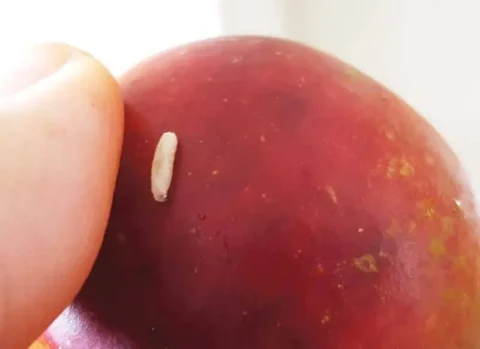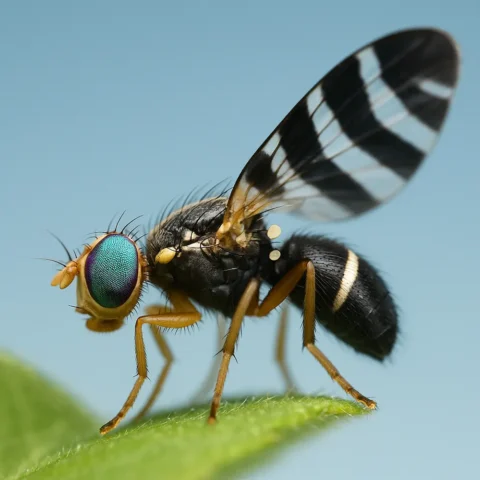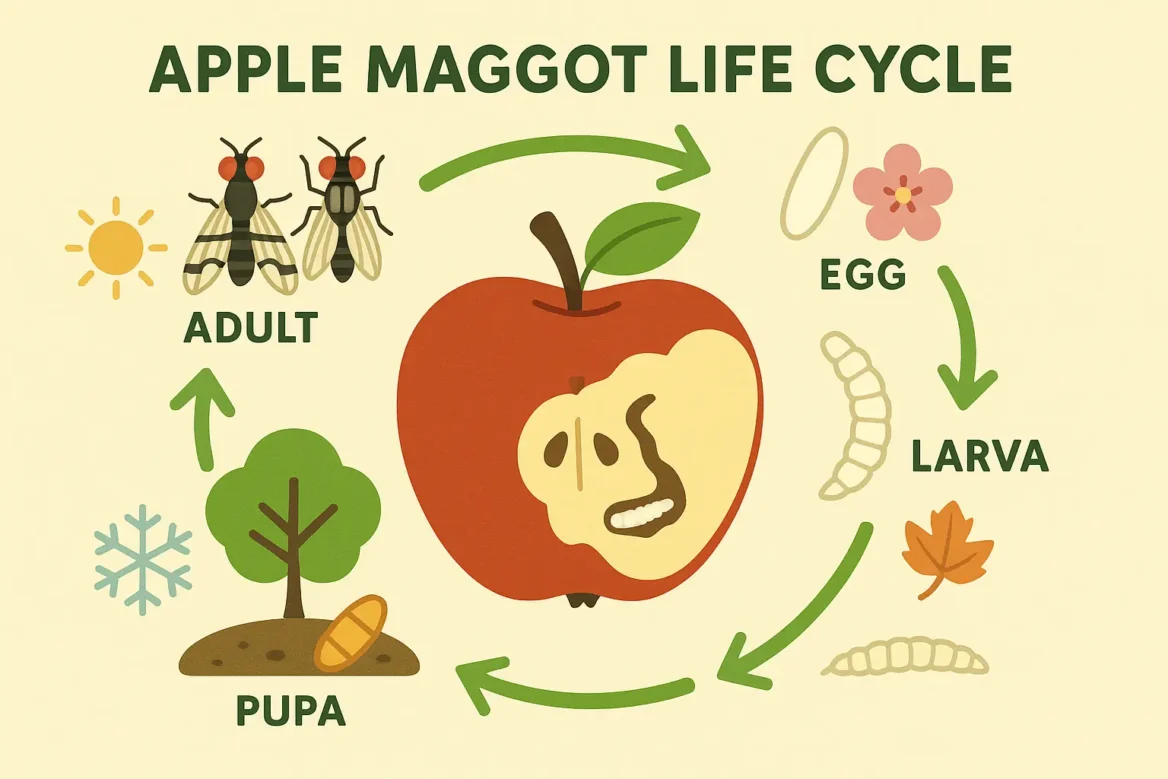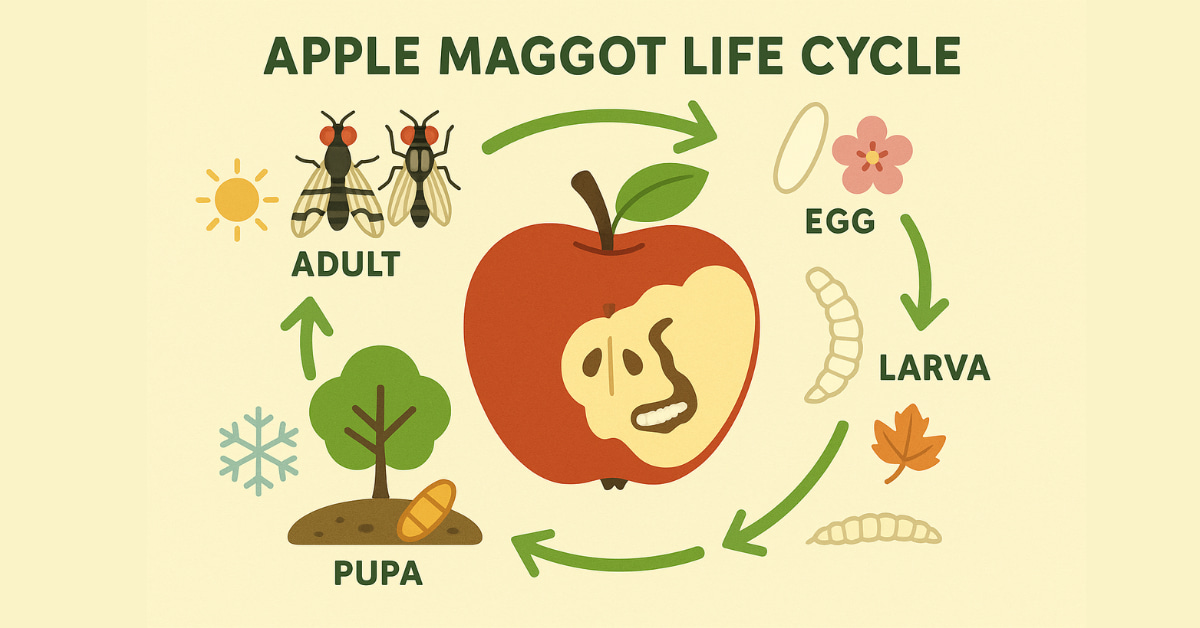As someone who geeks out over bugs (entomology, especially integrated pest management) and tries to live a sustainable, local life, finding a pest tearing through one of our best-loved local fruits really hits home.
It all started with a sprawling crabapple tree in my old backyard. So many juicy, mid-sized crabs! I was snacking on them raw, making applesauce, baking—and even then, the tree was still overflowing.
“Wow, a lot of fruit must go to waste around Edmonton,” I thought at the time.
That was before I really understood what was happening.
The first time I volunteered with Operation Fruit Rescue Edmonton (OFRE), the apple trees we picked seemed heavy with healthy, glossy fruit. But inside? Slimy, riddled with tunnels. It was a jaw-dropper.
“What is this dastardly bug ruining our apples?” I had to find out.
What Is Apple Maggot?
Turns out, Rhagoletis pomonella, the apple maggot, is a fairly new issue for Edmonton. It was first officially recorded here in 2005. The fly itself evolved as a new species from hawthorn maggot flies just a few centuries ago, after Europeans brought apples to North America. Today, it’s spread widely across the continent.
Here in Edmonton, it’s become a major headache for backyard growers and urban fruit lovers alike. You might hear it nicknamed the “Railroad Fly” or “Railroad Worm,” thanks to the telltale tunnels — or railroads — it leaves winding through the fruit’s flesh (source).


Apple Maggot Life Cycle
The adult flies are small—just a bit tinier than a housefly—with black bodies and clear wings marked by distinct dark bands that almost form a backward “F.” Their red-blue iridescent eyes even make them look charming, which is a constant struggle for bug nerds like me: appreciate the insect, loathe the damage.
Females lay eggs just under the skin of developing apples, usually one egg per site, leaving a faint puncture mark. Sometimes, you’ll notice a tiny dimple or dark spot. When the eggs hatch, the larvae—creamy white, legless little maggots—immediately start tunneling through the fruit as they feed and grow. This is the stage that causes most of the heartache: brown trails, internal rot, ruined apples.
Here’s an important observation based on my own experience: Maggots don’t wait for apples to fall.
Although many guides will tell you that maggots exit fallen fruit and drop into the soil, I’ve personally been rained on by tiny wriggling larvae while lounging under my apple tree.
If you want to truly prevent next year’s infestation, you can’t wait for apples to hit the ground.
Once fully grown, the maggots exit the apple, burrow into the soil, and pupate—essentially forming cocoons underground—where they overwinter. Come the next summer, they emerge as adult flies and start the cycle over again. In our northern climate, there’s usually only one generation per year.

How Apple Maggot Damage Shows Up
Discovering the damage these tiny invaders cause can be heartbreaking. I’ll never forget the first time I realized that fruit that looked perfect from the outside was a slimy mess inside.
Signs You Might Have Apple Maggots
- Brownish, winding trails through the apple flesh
- Soft spots or early spoilage
- Tiny dimples or dark puncture marks on the skin
- Bumpy, misshapen fruit
- Apples falling prematurely from the tree
Severely affected fruit often rots before you can harvest it. And worse still, if you’re hoping to sell apples at a market, infestation by apple maggot larvae renders them unfit for sale. In fact, this pest is serious enough to be listed as a quarantine concern in major apple-growing regions.

Not Just Apples
While apples are their favourite target, apple maggots also occasionally infest other plants—hawthorns especially, but sometimes cherries, plums, and pears too (source).
This means even if your tree is clean, nearby wild hawthorns or ornamental crabapples could reintroduce the problem.
The flies can travel 200–300 yards easily—apple maggot management really does require a community effort.
Managing Apple Maggots Organically
After watching my own beloved crabapple tree fall victim, I dove into research and tested different organic strategies that fit both backyard growers and sustainable living principles.
Organic Prevention Methods That Work
- Fruit Sanitation is Crucial
Pick up any fallen apples every single day during harvest season. Even one maggot-infested fruit left on the ground can fuel next year’s outbreak. Put infested apples in your green cart—not your backyard compost, unless you freeze or cook them first to kill larvae. - Use Monitoring and Trapping
Hang red sphere traps (which mimic ripening apples) and yellow sticky cards to catch and monitor adult flies. Red spheres work especially well for mating-stage flies, while yellow traps may catch a broader range (including some beneficials, so use with care). - Create a Protective Barrier
Spraying trees with kaolin clay (Surround WP) creates a film over fruits that deters females from laying eggs. It needs reapplying after rain but is an effective organic method. - Bag Your Fruit
For a smaller home orchard, you can bag individual fruits once they’re about the size of a dime. Mesh bags or special fruit socks work well and physically block access. - Encourage Neighborhood Participation
Since apple maggots don’t stay within property lines, working with your neighbors can make all the difference. Share knowledge, swap strategies, and maybe even coordinate a neighborhood-wide early fruit collection effort.
Want a hands-on demonstration of these organic strategies?
👉 Check out our upcoming Apple Maggot Control Workshop and get practical experience you can use right away!
Apple Maggot in Edmonton: A Growing Challenge
First spotted here just a few decades ago, apple maggot has rapidly become a significant pest in Edmonton’s backyards and community orchards. City guidelines encourage residents to pick up fruit promptly and dispose of it properly, but awareness remains a key hurdle.
Managing apple maggot isn’t easy—and it can’t be done alone. Even if you pick up every single fallen apple from your tree, a neighbor’s unmanaged tree just down the street could send fresh flies your way the following summer.
That’s why it’s critical that we work together as a community to learn how to recognize, monitor, and reduce this pest.
Can We Save Edmonton’s Apples?
It’s a big task. And honestly, it can feel overwhelming at times. But every apple we save, every tree we protect, strengthens our local food system.
By sharing knowledge, acting early, and managing our trees sustainably, we give Edmonton’s apples—and our community—a better future.
Want to get confident spotting apple maggot signs before they ruin your crop?
Join us for a hands-on workshop where we’ll cover all of this in detail! You’ll leave knowing exactly what to look for, what actions make the most difference, and how to help keep local fruit thriving.
👉 Register for the Apple Maggot Control Workshop
Happy harvest season—and here’s hoping for maggot-free apples this year!
Sarah
